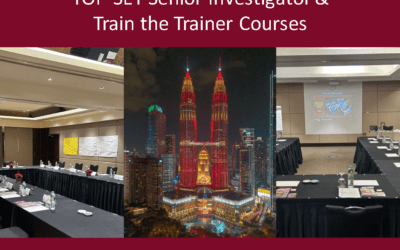At Kelvin TOP-SET we are frequently faced with people who are intimidated by the word ‘investigation’ itself, feeling that it is a difficult process at which only the police are expert, and that it implies that there must be a ‘culprit’ to blame in the end. It is always difficult to disabuse them of that idea; even some of those in the industries we work with still seem reluctant to believe it can be anything else. People can be put off coming on courses in case they find it too hard with a mystique covered in jargon!
So, when a police officer showed interest in TOP-SET, I was happy for him to come on our Senior Investigator course in exchange for his reactions and assessment of our method of investigation, and the difference between the two. His report to me is summarised as follows:
‘Having been in the police for a good number of years, I have a broad and in-depth understanding of criminal investigations. But having experienced the TOP-SET system, I have learned to take a step back from what is in front of me and focus more on the reasons for what has transpired.
Police investigations are always focused on evidencing an individual’s involvement in criminal matters. The findings are forwarded in a report and the case may or may not go to court. In general this type of police investigation is very much blinkered and single-minded. The evidence has a single and finite purpose: to incriminate the accused.
When using the Kelvin TOP-SET method of incident investigation, the attributing of blame is very much not the purpose. Although on completion of the investigation someone may be held accountable, this is secondary to finding the causes, the reasons why the incident occurred in the first place, and addressing these causes to prevent recurrence.
What I learned from this style of investigation is that there is a much bigger picture to be considered.
CASE STUDY:
A straightforward example of this in a policing environment could be something as simple as, for example, the theft of meat. On face value an individual has stolen meat and committed a crime. I investigate, speak with witnesses and obtain CCTV of the theft, arrest the individual and report the matter. He/she pleads guilty, gets a fine and is released. The next day they are most likely back in the same or similar shop committing the same crime. This then perpetuates until the individual is caught and the cycle begins again.
By using an approach like the Kelvin TOP-SET method of incident investigation at the first point of contact, more can be understood about the basis of the criminality. By repeatedly asking ‘why’ the crime was committed, you find numerous reasons for the theft:
- to fund a drug habit
- to provide food for the family
- to provide money to pay off bad debt
- because of mental illness
By finding the motive, by asking ‘why’, you may be able to address the issue:
- Drug habit – seek medical interventions such as rehabilitation programmes
- Food for the family – seek help such as food bank/benefit assistance/work assistance
- Debt – money advice and debt services/education about budgeting and finance
- Mental illness – medical assistance/counselling/self-management education
By understanding why the crime occurred and then finding assistance to address the ‘causes’, the need to re-offend is lessened. Criminal behaviour can be prevented.
Using what I learned on the TOP-SET course has really opened my eyes and increased my interest in the causes of crime rather than the short-term solution an arrest provides. The result has been me contacting outside agencies like Social Work, and alerting them to vulnerable individuals to deal with the underlying causes.
Taking the criminal out of the equation, and looking at the specifics as to why a particular individual or premises was targeted for a crime, has also been enlightening. I am an Architect Liaison Officer meaning that one of my functions is to assist in the design and layout of buildings and estates, to deter criminals. By asking ‘why’ the criminal targeted that specific supermarket, you can discover flaws such as:
- CCTV blind spot
- Lack of security or poorly placed staff
- Poor product placement (high value items close to the door)
This in turn can lead to advice on these matters allowing the store to address the issues, moving layouts or providing better staff training.
Again, by bottoming out the ‘whys’ rather than just dealing with the aftermath, this can lead to deterrence and possible prevention. The TOP-SET process and the Indicator Card can be used for Risk Assessment and so prevention. TOP-SET also helps you keep an open mind and not miss things.
In conclusion, by using the Kelvin TOP-SET method I have been able to expand my own style of investigation and make recommendations, in a police report to the court, about ways the court may dispose of matters, making offenders attend counselling perhaps. It has also assisted me in providing advice and assistance to the victims of crime.
In all, learning the Kelvin TOP-SET system really opened my mind and helped me to really look below the surface as well as seeing the ‘big-picture.’
Lorna Ramsay



